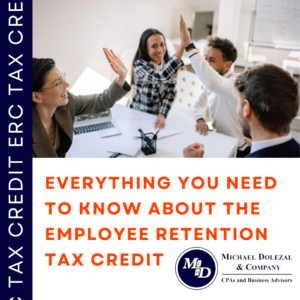Ever feel like you’re navigating a labyrinth when dealing with the ERC (employee retention tax credit)? You’re not alone. It’s a convoluted, continually shifting realm where even experienced entrepreneurs can get disoriented.
We’ve all been there: lost in government orders and partial suspensions, desperately seeking that glimmer of hope for our small businesses amidst gross receipts and quarterly federal tax returns. Yes, it feels overwhelming at times.
But what if I told you that this maze is actually hiding treasures? That your journey could lead to incredible benefits – like refundable tax credits, which help recover some of the revenue lost due to COVID-19?
Table of Contents:
- Understanding the Employee Retention Tax Credit (ERC)
- Qualified Wages and Full-Time Employees in ERC
- Interplay Between PPP Loan and ERC
- Impact of Government Orders on Small Businesses and Startup Recovery
- Claiming Process for Eligible Employers
- Special Considerations for Tax-Exempt Organizations
- Maximize Your ERC with CPA Needs
- FAQs in Relation to ERC (Employee Retention Tax Credit)
Understanding the Employee Retention Tax Credit (ERC)
The Employee Retention Tax Credit, or ERC, is a lifeline for businesses and tax-exempt organizations impacted by COVID-19. The American Rescue Plan brought significant changes to this tax credit designed to help those affected navigate financial uncertainties.
This refundable tax credit works against certain employment taxes. It was first introduced under the Coronavirus Aid, Relief, and Economic Security Act (CARES Act). But it’s not static; legislative amendments have since made it more accessible and beneficial.
Navigating the Complexity of the ERC
To give you an idea of its complexity: before March 2023, if your business received a Paycheck Protection Program loan, you couldn’t also claim this retention credit. However, now – thanks to revisions in government orders – even if you took PPP loans previously but faced lost revenue due to pandemic-related disruptions later on, your business could still qualify for ERC benefits.
This handy checklist from the IRS can be a great starting point in figuring out whether your business might qualify for these benefits based on gross receipts decline or partial suspension of operations, among other factors.
You may be asking, “How much is this worth?” Well, depending on specifics like qualified wages paid and employee count during different periods defined by law, it can cover up to $7K per employee per quarter. Yes, that’s right—as much as $28K annually.

Qualified Wages and Full-Time Employees in ERC
But understanding what counts as qualified wages can feel like walking through a maze.
Calculating Qualified Wages for ERC
In essence, qualified wages are the total compensation you’ve paid to your employees during any period when your business operations were fully or partially suspended due to government orders or during quarters where there was a significant decline in gross receipts. Now, this includes salaries, health benefits, and even some retirement contributions.
This handy checklist from the IRS gives an excellent breakdown of how employers qualify under these circumstances.
If you’re employing full-time workers, things get slightly more complicated – but don’t panic. The meaning of “full-time” in this context means individuals who average 30 hours a week or 130 hrs/mo. To clarify: it’s not about job titles; it’s all about the numbers.
A key fact worth remembering is that if you have over 100 employees (500 in 2023), only those wages paid to employees NOT providing services would be eligible for ERC credit.
You may ask, “Why?” It’s simple, really; bigger companies with deeper pockets are expected to weather economic storms better than smaller outfits, so they need stricter qualifying criteria set by Uncle Sam’s crew at the Internal Revenue Service (IRS).
Navigating the ERC maze? Remember, qualified wages aren’t just salaries – health benefits and retirement contributions count too. And it’s not about titles, but hours for full-timers. Big companies have stricter rules, though – Uncle Sam’s way of leveling the playing field.
Interplay Between PPP Loan and ERC
But fear not. With some guidance, you can navigate these waters.
The key is understanding how they interact. For instance, did you know that wages paid with forgiven PPP loans are not eligible for the ERC? Yet this doesn’t mean you’re locked out from both benefits. You just need to plan smartly.
A strategic approach might be to claim your PPP loan first and then apply for the ERC tax credit. The beauty here is that if your PPP loan forgiveness application isn’t approved, those payroll costs could still qualify for your ERC calculation.
Finding Balance: Maximizing Both Benefits
To maximize potential gains from both programs simultaneously requires a careful balancing act. If too much weight is given to one side—say using all of your payroll costs on forgivable expenses under PPP—you risk tipping over and missing out on potentially lucrative employee retention tax credits.
This scenario was common when many businesses believed they had to choose between either program, but in reality, it’s about finding balance and taking advantage of both provisions as appropriate based on individual circumstances.
Pitfalls To Avoid: A Word Of Caution
Beware though. There are pitfalls waiting around every corner, chief among them being inadvertently claiming the same wage twice under different programs – a big no-no, according to the IRS.
Another crucial point: The IRS recently announced a moratorium on processing new claims for the ERC program as part of their ongoing effort to protect against scams, making it more important than ever that your application is accurate and timely.
Key Takeaway:
Small business owners can maximize benefits from both the ERC and PPP loans with smart planning. Use a strategic approach, like claiming your PPP first and then applying for the ERC tax credit. It’s about finding a balance between both programs based on individual circumstances. Avoid pitfalls like double-claiming wages under different programs – it’s a big no-no.
Impact of Government Orders on Small Businesses and Startup Recovery
The onset of the pandemic saw a flurry of government orders. While some proved beneficial, others posed significant challenges for small businesses and startups.
For instance, shutdowns or partial suspensions due to government orders affected gross receipts dramatically. Many small employers found themselves struggling with lost revenue while trying to keep their doors open.
Navigating Through Government Orders
In response to these struggles, the American Rescue Plan introduced an incentive in the form of ERC tax credit. This refundable tax was designed specifically for eligible business owners impacted by such circumstances.
This lifeline aims at helping organizations rebound from financial difficulties brought about by restrictions tied to COVID-19. The relief offered can help offset some operating costs associated with wages paid during periods when normal operations were disrupted because of governmental directives.
A Beacon for Startups
Besides existing small businesses, startups formed after February 15th, 2023, also got a boost under this rescue plan through what’s known as recovery startup provisions.
To qualify under these terms, however, your startup needs less than $1 million in annual gross receipts and should have begun its trade or business after that date – offering new ventures a chance at revival amidst challenging times. Here’s more information on it.
Making Use Of Refundable Tax Credits
If you’re eligible as per guidelines laid out by the Internal Revenue Service (IRS), you may file amended return claims via Form 941-X for qualified wages paid within relevant quarters – thus recovering part of those crucial expenses. Check your eligibility here.
Remember, the ERC program is a significant tool for businesses grappling with reduced revenues due to pandemic-related orders – it’s an opportunity not to be missed.
Key Takeaway:
The pandemic hit small businesses hard, but the ERC tax credit offers a lifeline. It helps cover costs tied to wages during disruptions caused by COVID-19 restrictions. Startups formed after February 15th, 2023, can also benefit from this plan. And if you’re eligible, you could recover some expenses through amended return claims.

Claiming Process for Eligible Employers
If you’re an eligible employer, the process of claiming your Employee Retention Tax Credit (ERC) can feel like navigating a maze. But don’t worry. We’ve got your back.
Filing Requirements for ERC
To start with, let’s talk about payroll tax and qualifying wages – two crucial aspects of this journey. As per IRS guidelines, only those wages that are not paid out from PPP loan proceeds qualify towards ERC calculation.
The second step involves filling up Form 941-X to claim your refundable credit on these qualified wages if you have already filed employment taxes via a quarterly federal tax return. Yes, it sounds complicated but trust us; it’s just part of the process.
A critical point to remember is that startups or ‘recovery startup businesses’ established after February 15th, 2023, also need special attention while filing claims under this provision due to their unique business status and structure.
Last but not least, maintain clear records of all employee payrolls, including health plan expenses which may count as qualified wage costs based on IRS rules and guidance related to COVID relief measures such as the CARES Act.
In essence: Be meticulous with documentation. It’s vital because proofreading will help avoid any unnecessary hassles during potential audits down the line by IRS officials checking for compliance against laws governing recovery funds allocation post-pandemic era.
Navigating the ERC maze? Keep calm and follow our guide. Remember, not all wages qualify, use Form 941-X for claims, and startups need special care. Documentation is king to avoid audit headaches.
Special Considerations for Tax-Exempt Organizations
For tax-exempt organizations, the Employee Retention Credit may be a saving grace. But there are some special considerations to keep in mind.
Claiming the ERC as a Tax-Exempt Organization
Your status doesn’t exempt you from benefitting from this credit designed specifically to encourage businesses affected by COVID-19. The trick lies in understanding how employment taxes are treated and which expenses qualify under this program.
You might think that as an organization with tax exemption, claiming such credits may not apply to you. You’d be surprised. It’s about retaining employees and helping them weather this storm – something we all need help with right now.
The key is knowing what qualifies as wages. Only then can you accurately calculate your refundable tax credit on your federal tax return or even consider filing an amended return if necessary.
Certain costs related to health benefits could also fall under qualified wages paid, making it more appealing for small employers like yourself. So why not take advantage of these government orders aimed at easing financial burdens?
- Pick up those calculators: Remember only certain payments made towards employee salaries count toward the ERC; know exactly what they are before starting any calculations.
- Dive into details: Check out 10 Best Credit Card Processors for Nonprofits, where they cover how processing fees impact organizations like yours when considering qualifying expenses.
- Avoid penalties: Don’t forget about filing requirements. Ensure correct documentation is filed alongside accurate figures on Form 941, Employer’s Quarterly Federal Tax Return, to avoid any unpleasant surprises from the Internal Revenue Service.
With a bit of homework and due diligence, tax-exempt organizations can also enjoy the benefits of ERC. So don’t miss out; it’s time to get those numbers crunched.
Key Takeaway:
As a tax-exempt organization, you, too, can benefit from the ERC. Remember, it’s about employee retention and helping them through tough times. Understand what qualifies as wages to accurately calculate your credit; include health benefits costs where applicable. Be meticulous with documentation on Form 941 to avoid penalties. Get those calculators out—it’s time for some number crunching.
Maximize Your ERC with CPA Needs
Unlocking the ERC (employee retention tax credit) isn’t easy, but it’s worth every step. Remember: you aren’t alone. At CPA Needs, we can help. Reach out to our team of experts today to ensure your business doesn’t miss out.
FAQs in Relation to ERC (Employee Retention Tax Credit)
Who qualifies for the ERC tax credit?
Firms impacted by COVID-19 shutdowns or seeing significant revenue drops can qualify. Full-time employees are a must, though.
Has anyone received an ERC refund in 2023?
The IRS is still reviewing claims and hasn’t released official data yet. So it’s unclear who has gotten refunds.
How should ERC be reported on a tax return?
You need to report the ERC on your payroll tax return, Form 941. Just include it with other employment taxes.
How do I claim my ERC refund?
To get your refund, you file Form 7200 with the IRS after figuring out your eligible wages and calculating the credit.












